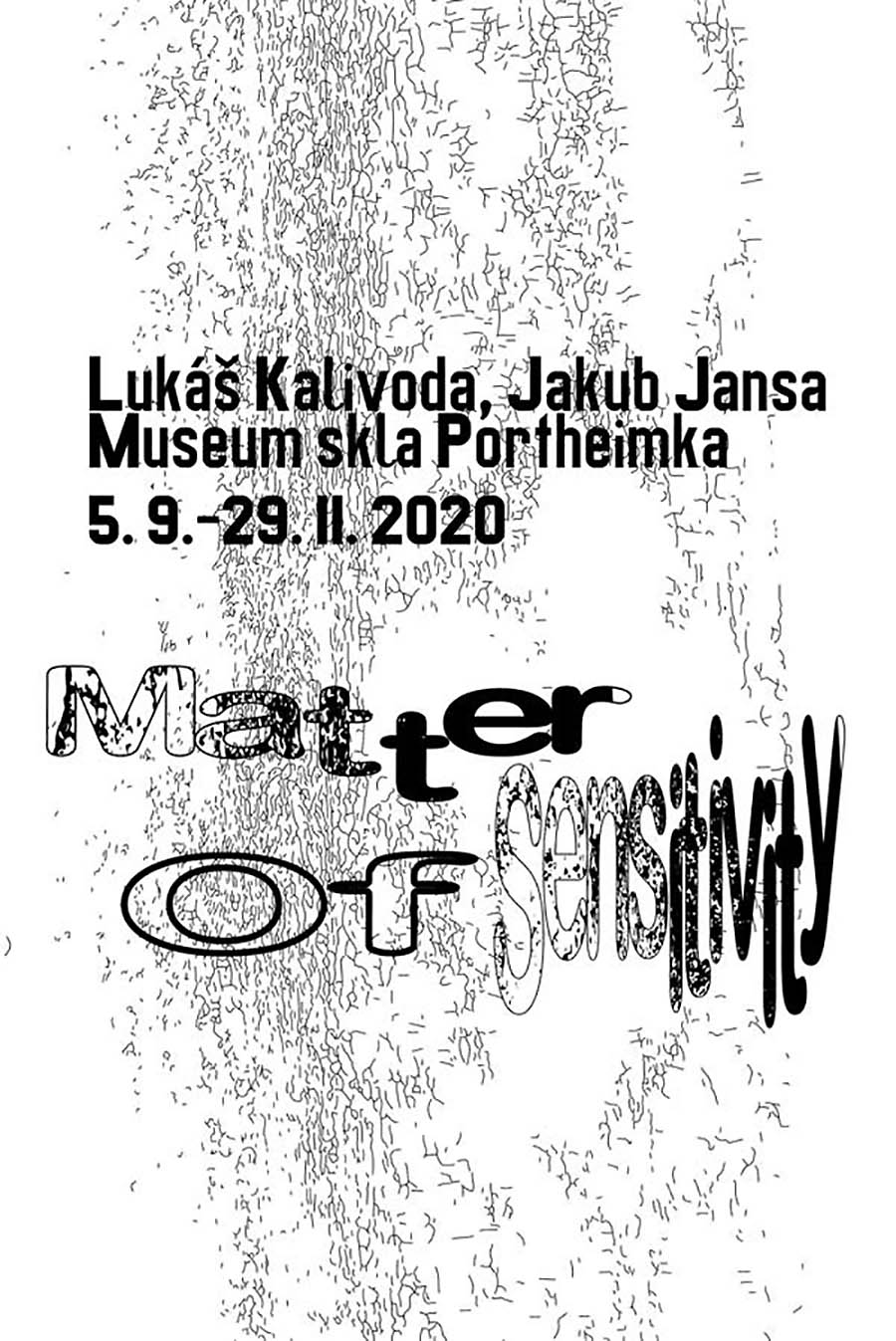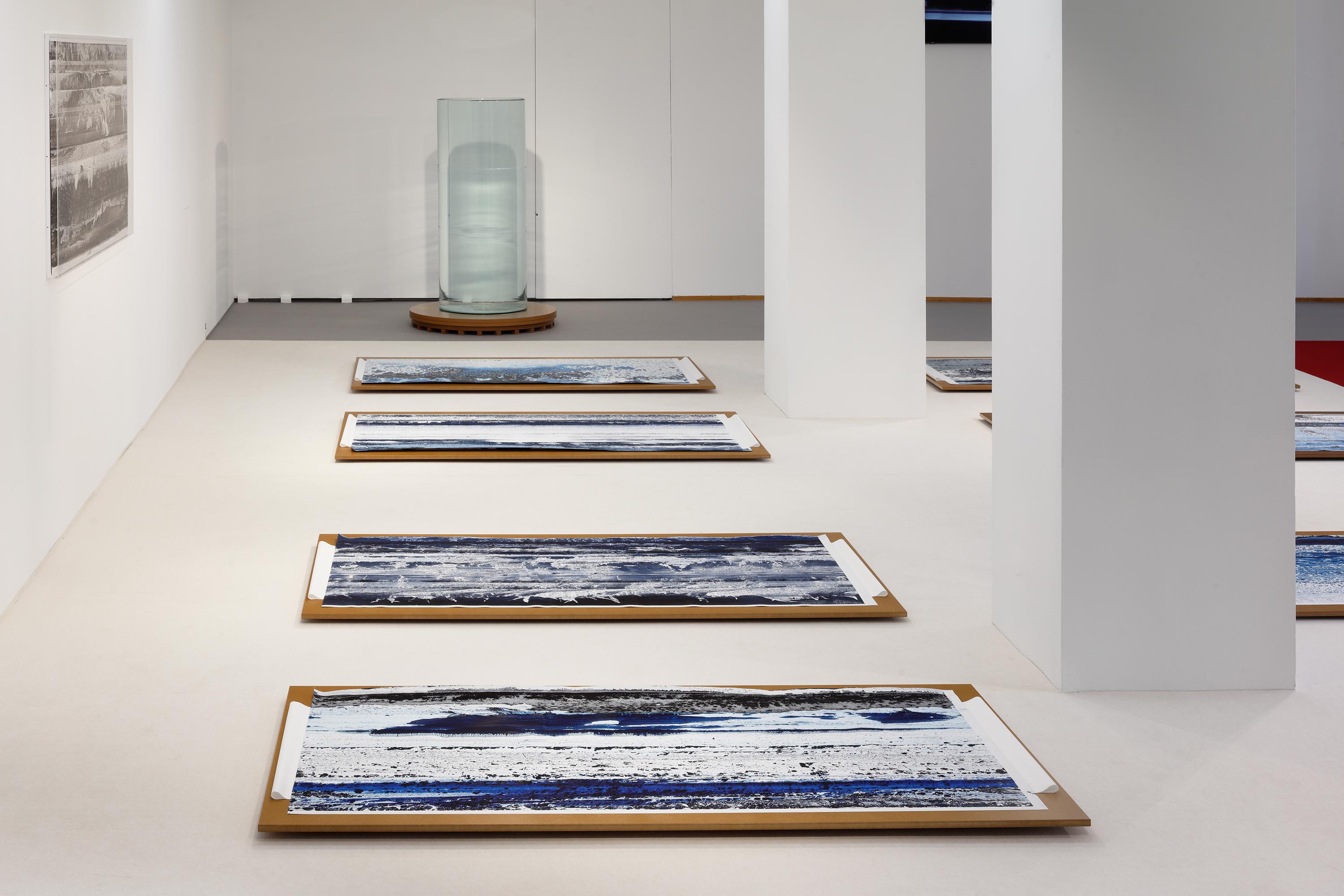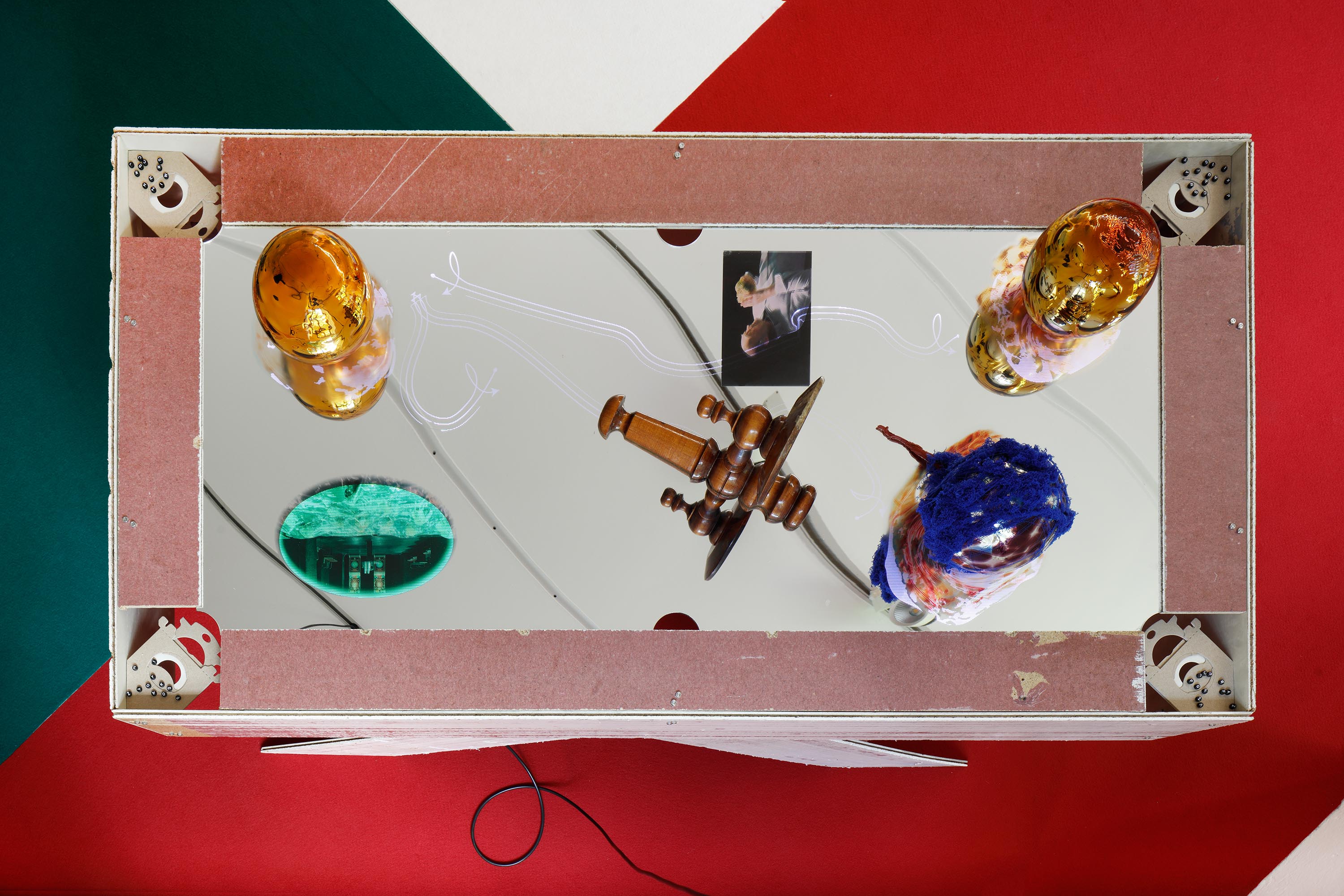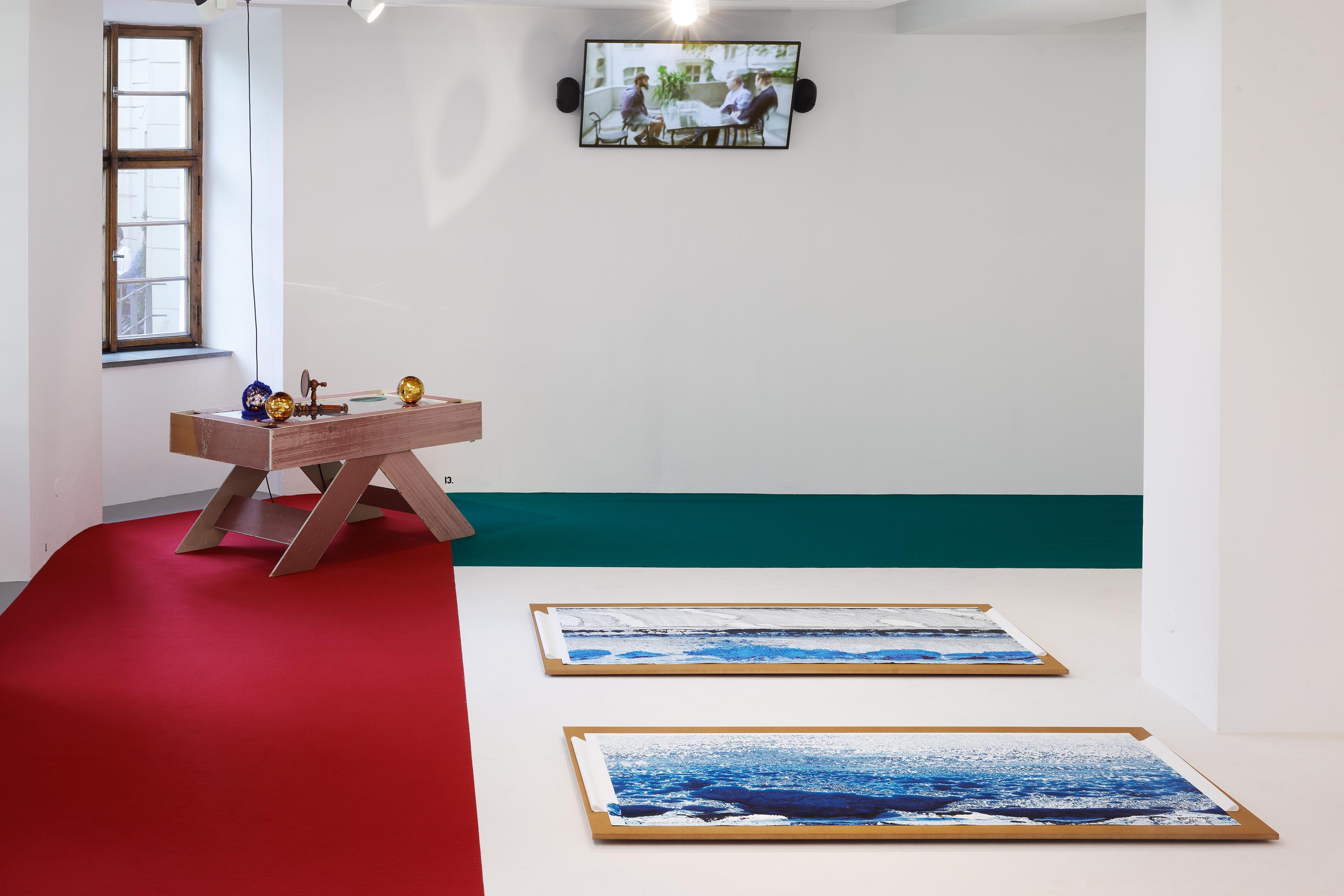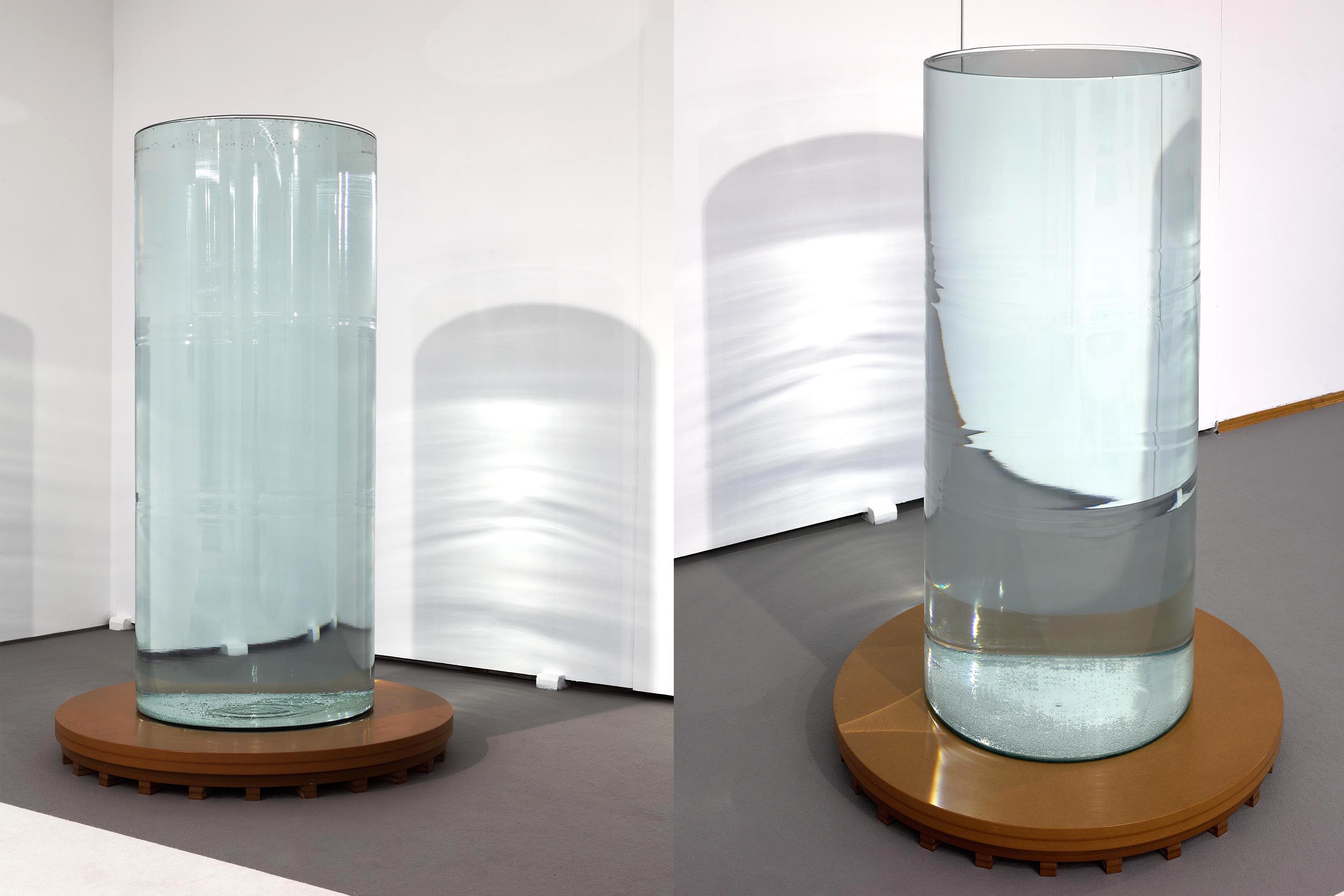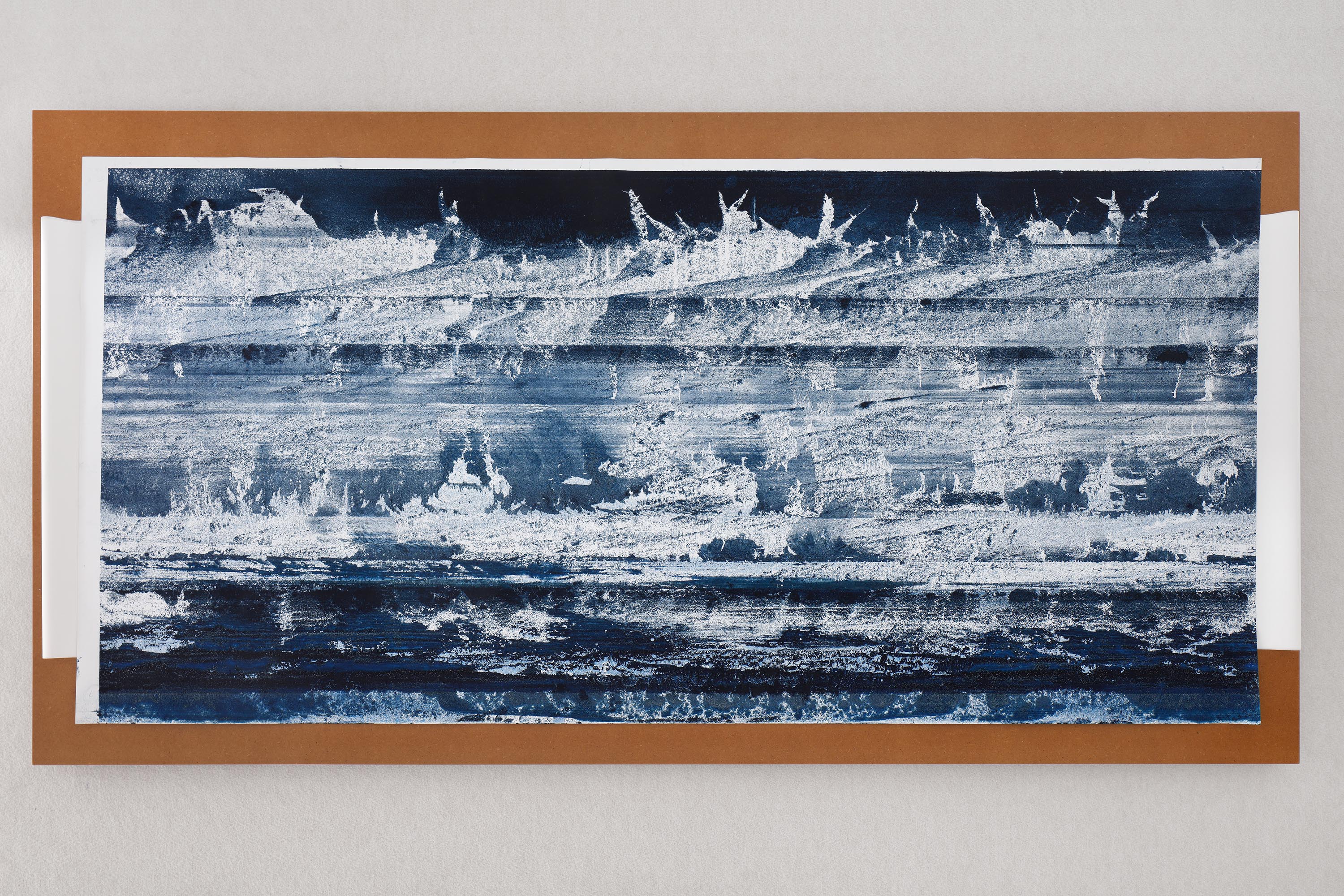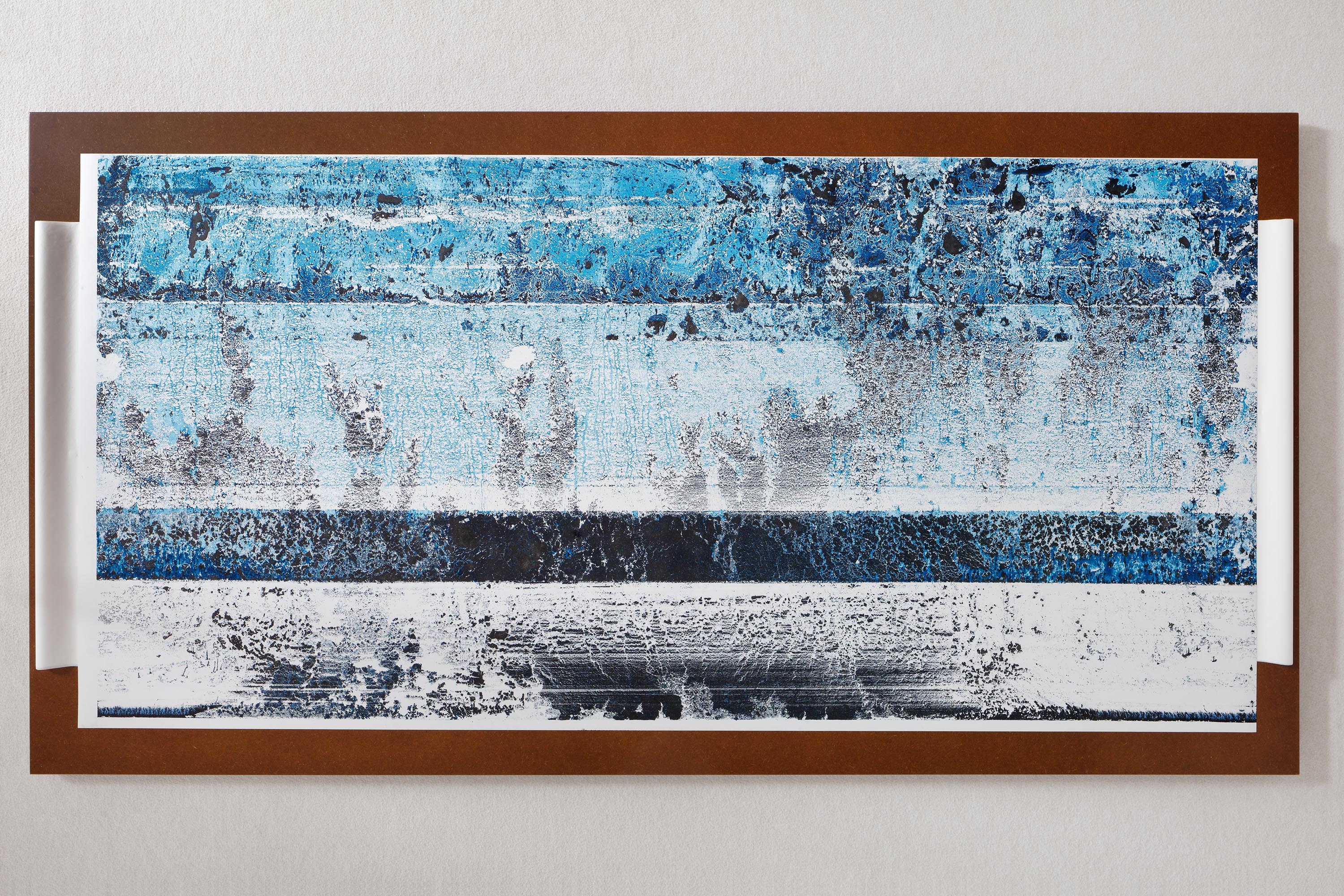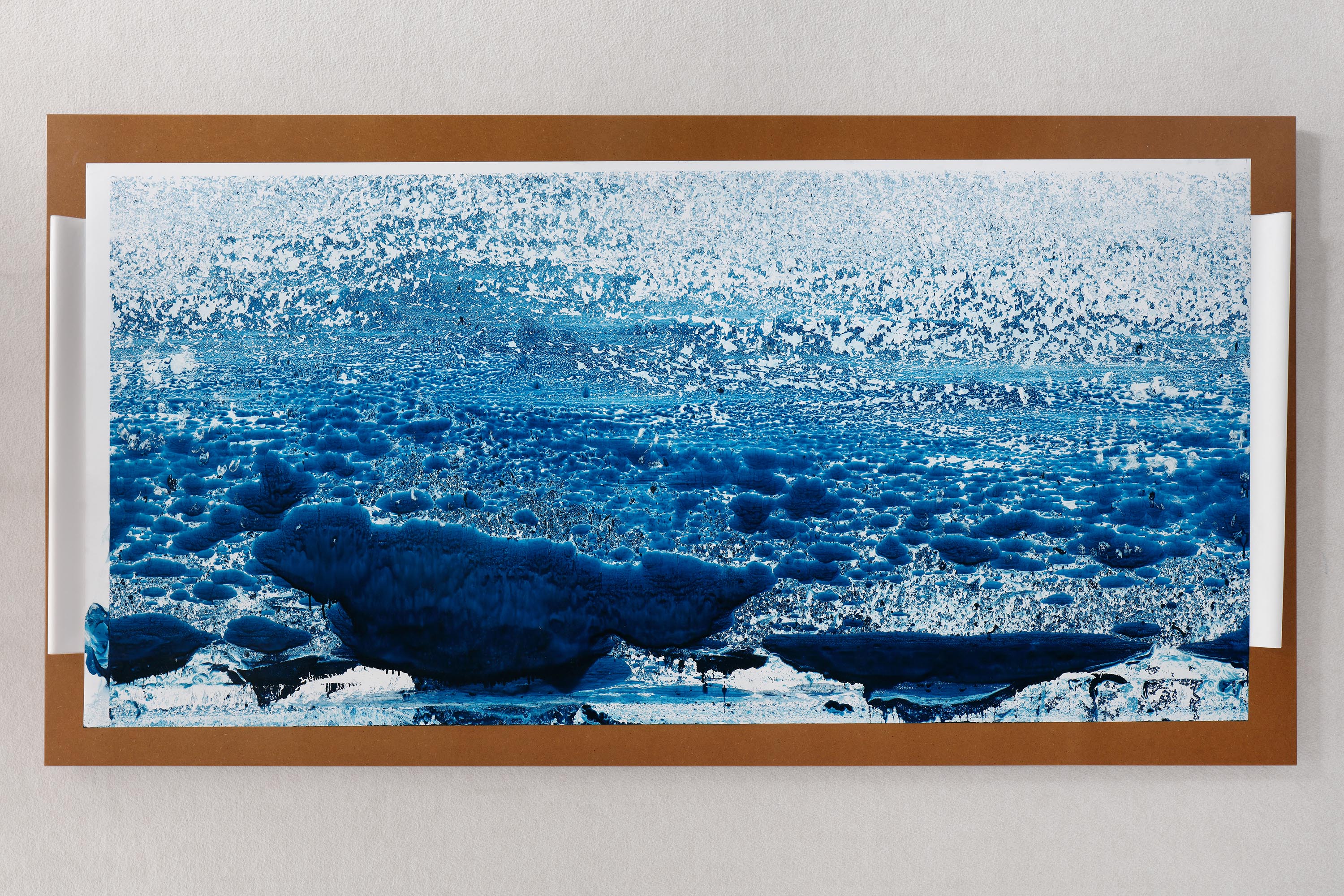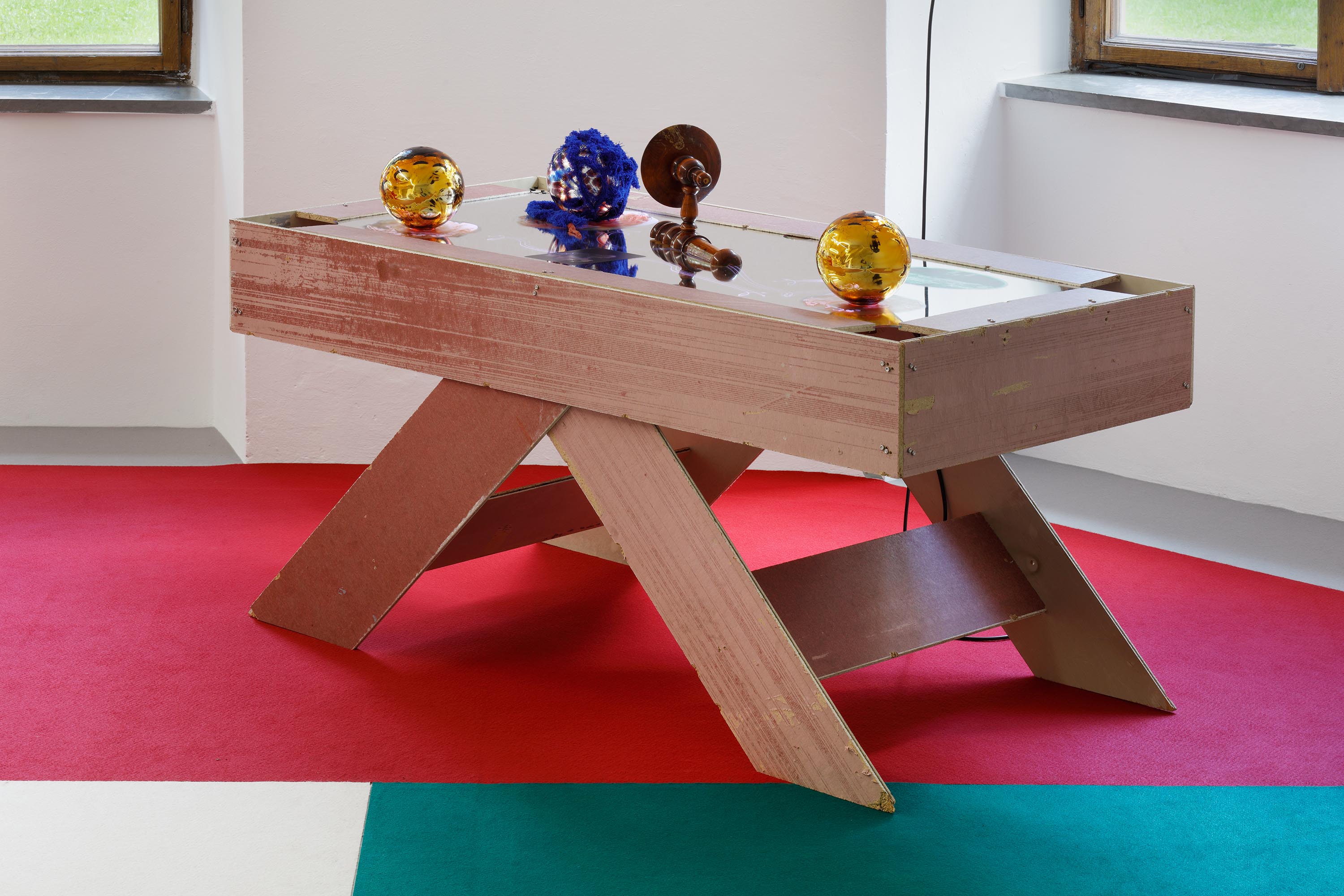Exhibition Matter of sensitivity is a joint presentation of Lukáš Kalivoda’s and Jakub Jansa’s works. Both belong among young, yet already distinct artists. It is an encounter of two author’s approaches – Lukáš Kalivoda works with glass and develops author’s painting techniques while Jakub Jansa focuses on the medium of dynamic image and on work with the genre of installations. The works of both artists may be understood as experimental, multi-layered in terms of meaning, yet attractive for audience.
They have prepared a representative insight into their work. Lukáš Kalivoda presents a series of paintings created with his own author’s technique – by taking a film of paint off water level. He fits foil on the inner side of a large cylinder. He then fills the cylinder with water and pours paints diluted in turpentine or various diluents into it. The solution creates a surface film. He then gradually withdraws the water from the cylinder. As the level drops, the pigments get caught on the surface of the foil. The individual steps of releasing the water create subtle transfers of colours as well as a typical line structure of the image. A part of the exhibition is also his installation called Chvění hladiny (Quivering Surface). It is a glass cylinder filled with water to the brim. We can see the water surface vibrate and ripple subtly. The ripples of the surface and their visual reflections may be perceived as an inconspicuous latent image hovering on the edge of substantiality as well as of our perception.
Jakub Jansa often works with narration. We know the principles he uses from media or social networks. However, he disrupts their visual and information strategies and shifts them in terms of meaning, uncovering thus various forms of manipulation as well as deeper hidden ‘poetically metaphorical’ motifs. Within the current media discourses or habitual forms of perception, he thus discovers (and, of course, also creates or implants in them) structures which hold inside certain almost mythopoetic elements. A part of this set is also his installation Occult table. It is a variation of an object belonging to a broader series of installations, performances and video projections titled Club of Opportunities. As the references to this large project may not be sufficiently unfolded in the context of a rather intimate joint exhibition, we encounter a work functioning as a fragment, as a reference to an absent whole. The entire object thus becomes more enigmatic and more ambiguous. Another Jakub Jansa’s work is a video titled Celery ASMR. What captures our attention apart from its odd atmosphere is its detailed soundtrack – the phenomenon of ASMR (autonomous sensory meridian reaction) shifting the auditive experience to a literally intimate and genuinely physical level.
A part of the exhibition is also a video conceived as a specific visually-rhetoric commentary featuring the curator of the exhibition as well. In terms of genre, it is a loosely conceived video-essay interconnecting the individual artifacts. The purpose of the video is double: it should interconnect the works of both participating artists in terms of meaning and explain them and, at the same time, to complicate them slightly. This is given by the fact that the curator performs a double part – both as an ‘independent’ person and as a part of the game, which means that he is actually acting his ‘independent part’.
These duplicated essayistic readings try to interconnect both artistic projects in a discursive way – to show the exhibition as a whole within which both artists together create a certain ‘floating zone’, which each of them enters from his own side. The overlap of one to the position of the other may be understood as a part of their joint experiment: a connection of two artistic personalities, complementing and differing from each other at the same time.
Apart from this discursive connection, it is especially a detailed sensory experience what connects both artistic projects. Lukáš Kalivoda explores the substantivity of visual forms, pigments, and emulsions while Jakub Jansa overwhelms us with ‘auditive matter’. This way, they are suggesting us to immerse in the experience and sensory exploration of the presented works, in all the visual or auditive perception they are offering, to observe them carefully and let them carry us away…
Profiles of authors:
Lukáš Kalivoda (1986) works with glass and develops author’s painting techniques. In 2006 to 2012, he studied at at The Academy of Arts, Architecture, and Design in Prague at the Studio of Glass led by Vladimír Kopecký and later Rony Plesl.
He builds upon the professional experience of a glass-maker – as he is an experimental author, the material and technologies connected with this craft become a source of further inspiration for him. Presently, he focuses on a technically and technologically innovative painting technique of taking films of paint off the surface of water. This way, large-format paintings are created, which combine a controlled laboratory-workshop process with the freedom of their natural origin.
Exhibitions (selection)
Malba vodou (Painting with Water), MeetFactory, Prague, 2018; Tiskárna (Printer), Automatické mlýny (Automatic mills), Pardubice, 2018; participation: IGS – International Glass Symposium, Nový Bor, 2018
Jakub Jansa (1989) works with video, installations, and performances. In 2011 to 2016, he studied at The Academy of Arts, Architecture, and Design in Prague at the Supermedia Studio led by Federico Díaz and David Kořínek. During the period of 2017 to 2019, he led the studio of Temporary Arts at the Film and TV School of Academy of Performing Arts (FAMU) as a visiting pedagogue.
Jansas’ artistic thinking is influenced by current visual and media strategies. He uncovers various forms of manipulation and information shifts in them. At the same time, he also discovers deeper hidden motifs and tendencies in them – a certain, hitherto undiscovered, mythopoetic heritage. Jansa often works with stories and seeks a message, but as his work with narratives takes place on a formally complicated discursive-poetical level, he does not tell us his ideas directly, but in metaphors, hints, ironical shifts, or he opens almost absurd aspects of the depicted situation in specifically over-illuminated expositions.
Exhibitions (selection)
Project Club of Opportunities: HeK, Basel, Switzerland, 2019; Ten Years Night (Club of Opportunities Ep. 6), Fotopub Project Space, Ljubljana, 2019; Pioneer Works, New York, USA, 2018; Anti-, The 9th Athens Biennale, Greece, 2018; Britannica Bootcamp (Club of Opportunities Ep. 4), CEAAC, Strasbourg, France, 2018; My name is Red Herring (Club of Opportunities Ep. 3), Fotograf Gallery, Prague, 2018
Kamil Nábělek (1964) is chiefly interested in modern and contemporary art. He focuses mainly on its theoretical and methodological questions. Having graduated from the Faculty of Arts, Charles University (art history, aesthetics and philosophy), he worked as a curator of the sculpture collection in the Collection of Modern and Contemporary Art at the National Gallery in Prague, lectured at the Department of Art History and Aesthetics of the Academy of Arts, Architecture and Design in Prague. At present, he teaches at the Faculty of Arts and Architecture of the Technical University in Liberec.
Selected Publications:
Kamil Nábělek, ed., Václav Navrátil: Umění a metafyzika (Václav Navrátil: Arts and Metaphysics), Praha, Torst 2018.
Kamil Nábělek, Umělecké dílo jako exemplární paradigma a dialektický obraz. Analogie mezi koncepty Giorgia Agambena a Waltera Benjamina (An Artwork as an Exemplary Paradigm and a Dialectical Image: An Analogy between the Concepts of Giorgio Agamben and Walter Benjamin), Sešit pro umění, teorii a příbuzné zóny 24, 2018, pp. 6–40.

